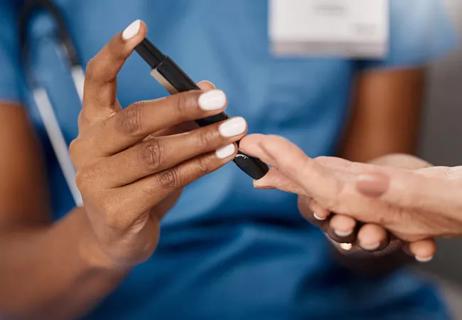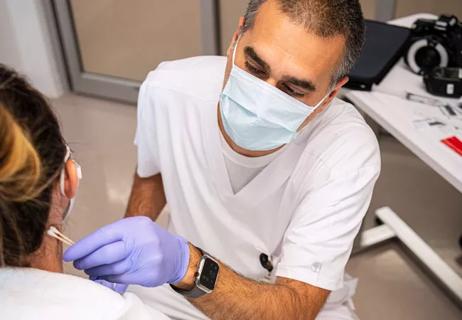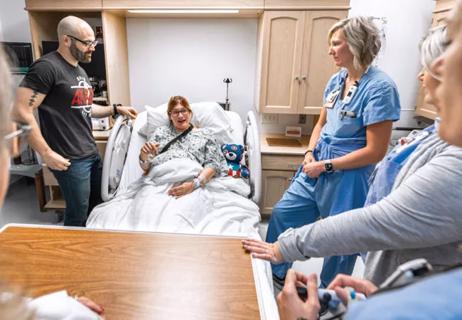Program encompasses all areas of perioperative nursing

In 2019, the Stanley Shalom Zielony Institute for Nursing Excellence Perioperative Education team, in partnership with the Ursuline College School of Nursing, launched a one-of-a-kind perioperative clinical immersion program for nursing students.
Cleveland Clinic is a non-profit academic medical center. Advertising on our site helps support our mission. We do not endorse non-Cleveland Clinic products or services. Policy
The hands-on immersive program delivers sophomore and junior level nursing students in a baccalaureate program perioperative-specific hands-on experience and skills training. From didactic instruction to simulation exercises and real-world experience in the perioperative setting, the program encompasses all areas of perioperative nursing – preoperative, intraoperative and postoperative (phase I and II).
“When developing this program, we wanted nursing students to know that perioperative nursing is a great place for new graduates to begin their nursing careers,” says Linda Gardner, DNP, MEd, RN, CNOR, Surgical Nursing Education Manager at Cleveland Clinic. “It offers a unique experience and comprehensive perspective on the perioperative setting.”
The clinical immersion program is designed to provide nursing students the ability to learn about and fully participate in the role of the perioperative nurse by introducing perioperative nursing into the academic curriculum.
Students participate in the program over the course of two semesters, once as a sophomore and once as a junior. At Ursuline College, the program is a featured component of the nursing school’s medical-surgical nursing courses (Med-Surge I and Med-Surge II). The program aligns with the objectives and learning outcomes of the academic nursing program and focuses on the environment of care, infection prevention, assessment, safety, communication and advocacy.
As sophomores, students begin the program by participating in a 4-hour foundation-building class on the essentials of perioperative nursing. The class includes preoperative assessment, IV skills, the physical environment, gowning, gloving, sterile and aseptic technique and the postoperative assessment. A variety of teaching methods are used, including didactic instruction, gaming, simulation and small group interaction.
Students then participate in two 6-hour clinical experiences, which are facilitated by preceptors (with a minimum of 2 years of experience) and include the three distinct care areas. However, the majority of students’ time is spent in the operating room.
“In this program, students aren’t just watching or observing – they are actively participating,” adds Gardner. “They help admit patients, put in IVs, work with specimens, help position patients for surgery, and more.”
As juniors, in the second semester of the program, there is no classroom portion and students obtain additional clinical experience in all three settings. Clinical experience is increased to four 6-hour experiences.
Cleveland Clinic first offered the clinical immersion program to Ursuline College nursing students in the Fall of 2019. In that semester, 42 students completed the program. To date, nearly 70 Ursuline students have participated.
Additionally, the Perioperative Education team recently expanded the program. Announced for the Fall 2020 semester, the program now also includes an ‘accelerated student track.’ This track is designed for students who can complete the program on a faster timeline, such as those going back to nursing school to earn a second degree. Students in this track complete the classroom experience and one 12-hour shift in their first semester, then participate in two 12-hour shifts their second semester. Gardner says adding the accelerated student track welcomed an additional 15 students to the program.
Students and preceptors alike have had provided extremely positive feedback about the perioperative clinical immersion program. Student feedback has included statements, such as:
“Bringing students into the perioperative environment allows them to see the teamwork and effective communication required in this setting and how to truly be a patient advocate,” says Gardner. “It builds confidence in these future caregivers and showcases the importance of nurses, physicians, and all caregivers working together to collaborate and meet the needs of the patient.”
In the future, Cleveland Clinic’s nurse leaders plan to offer the clinical immersion program to more nursing schools. The health system already has a similar program in place at Case Western Reserve University.
In addition to providing nursing students the ability to fully participate in the role of the perioperative nurse, Cleveland Clinic’s clinical immersion program also helps reintroduce perioperative nursing into education curriculum.
Carol Pehotsky, DNP, RN, NEA-BC, ACNS-BC, CPAN, Associate Chief Nursing Officer for Cleveland Clinic’s Surgical Services notes that perioperative nursing as a formal course in nursing school was largely removed from pre-licensure nursing programs in the 1980s and 1990s – thus, many nurses didn’t have exposure to perioperative nursing in school and found their way to operating room (OR) nursing as part of a longer journey.
She says, “We sometimes hear new nurse hires say they thought they had to have medical-surgical nursing experience first before considering perioperative nursing. However, we are proud to hire newly graduated nurses into our perioperative nurse residency as well as nurses who have other nursing experience. In fact, we find that success rates of each are very similar.”
Historically, baccalaureate nursing programs have offered perioperative observational experiences, which are highly beneficial, but often focus on surgical procedure and not necessarily the role of the perioperative nurse. Additionally, with competing content in curriculum, some programs have had to eliminate observational experiences. With factors like these and more, student nurses often have very low exposure to the perioperative setting during nursing school, when compared to other specialties.
In fact, one survey featured in an AORN Journal article cited that less than 7 percent of nurses reported entering the perioperative nursing specialty as new graduate nurses.
Additionally, a 2015 AORN white paper on nurse staffing suggested that 65 percent of all OR nurses in the U.S. will be eligible to retire by 2022. With this projected shortage, the need for more perioperative nurses is widely evident.
“Having a competent workforce contributes to patient safety, efficiencies and quality outcomes,” says Pehotsky. “We know we need to continue to recruit and retain OR nurses now and into the future – and we can’t do that without an awareness of what our specialty entails, and how amazing it can be.”

Nurses play pivotal role in patients’ ability to recover in the comfort of their own homes

Advocating for patient safety is imperative in fast-paced surgical settings

Advice for those pursuing a WOC nursing career

Redesigned protocols enhance infection-prevention measures

Longevity in healthcare, personal experiences may provide caregivers with false sense of confidence

Specialized team prioritizes trauma-informed care and evidence collection

Collaborative approach leans on expertise of nurses

TeamBirth aims to improve outcomes by facilitating collaboration between patients and caregivers